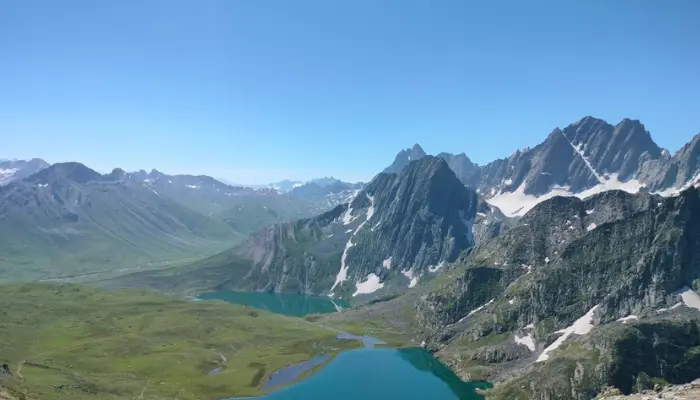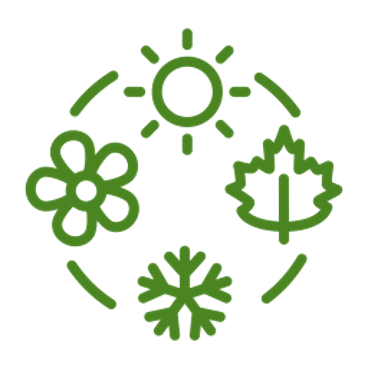
Kashmir Great Lakes Trek
TREK DIFFICULTY
Easy - Moderate
TREK DURATION
7 Days
HIGHEST ALTITUDE
13,800 Feet
GROUP SIZE
6-12
TREK DISTANCE
75 KM
BASECAMP
Kashmir Great Lakes | Kashmir
BEST TIME
July to September
PICKUP POINT
Kashmir (Nishat Garden, Srinagar)
Kashmir Great Lakes Trek Overview
Kashmir Great Lakes Trek is the most popular hiking trail to experience the never-ending beauty of Kashmir region in North India. This high altitude alpine trek is located in Ganderbal district of Jammu and Kashmir. Alpine lakes are the main attraction during the trek, it passes through some of the most beautiful and huge sized alpine lakes of India like Vishansar, Krishnansar and Gangabal. Kashmiri Hindus associate Vishansar Lake with Lord Vishnu, Krishnansar with Lord Krishna and Gangabal Lake with the holy Ganges which fills spiritual energy from within, also, many yoga practitioners come to this trek to increase their spiritual

Interestingly, every lake has a unique color and view. Similarly, there are a total of 6 large lakes on the route and that is why this trail path is named "Kashmir Great Lakes". During the trek, one can see alpine lakes as well as shepherd huts, spiritual places around the route, many small water bodies, glaciers, beautiful meadows, mountain peaks and high passes. Trekkers who have traversed this route spoke about the beauty of the trek as per their experience. Shivam, a former trekker of Himalaya Shelter said, “I have done many treks in Andhra Pradesh, Madhya Pradesh, Sikkim, Arunachal Pradesh, Himachal Pradesh and Uttarakhand but this Great Lakes trek in Kashmir turned out to be the best and indeed a great trek because its beauty is something you can’t describe in words, it is all about seeing and capturing it in your heart, that’s all.”
Starting from Sonamarg Basecamp and ending at Naranag, the trail covers a distance of about 75 km. The duration of the trek depends on the itinerary selected by trekkers. Himalaya Shelter provides a safe and perfect itinerary to explore trek very well, which takes 7 days to complete including transport from Srinagar and return to the same point. This trek takes you to a maximum altitude of about 13,800 ft at Gadsar Pass, which is also the most challenging but not technical part of the trek, and safety precautions are potentially necessary at this point. Although Mount Haramukh (5,142 m (16,870 ft)) is the highest mountain peak visible during the trek, and one can see the peak from very close, trekking through the peak is not a part of the trek.
This trek is considered moderate to difficult in terms of difficulty level as it involves daily long distance walking, crossing high altitude passes, several steep ascents and descents, and passing through some rough terrain sections. This is why it is suitable only for experienced trekkers and may be for beginners who have a good level of physical fitness. The trail starts with a gradual climb to the Table Top (one of the few places during the trek where BSNL and Jio networks can be found) and the Nichinai Pass. Throughout the trekking route, trekkers pass through several steep ascents and descents. These multiple ascents and descents reduce the chances of AMS during the trek, as trekkers climb to a top point and then descend to a lower altitude point for night camping, but even then the chances of AMS and breathing problems are not zero.
It requires great physical and mental fitness and, therefore, it is important to prepare yourself for the trek at least a month in advance. Also, choosing the right time for the trek can help reduce the difficulty of the trek. The best time to go on the Trek is during the monsoon months from July to September. Although this may sound unusual, the monsoon is actually the best season to go on this trek.
While other regions of India, such as Himachal Pradesh and Uttarakhand, are almost closed due to heavy rainfall, some areas of Kashmir offer trekkers the inspiration to trek even in the rainy season. The region where the trek is located receives less rainfall and has perfect weather conditions for trekking. This is an ideal time to see the beautiful landscapes of Kashmir, while other areas may be negatively affected by heavy rains and closures.

Due to the difficulty of the route and the requirement of trail permits, it is important to join trekking groups organized by Himalaya Shelter or any other reputed tour operator. We are one of the leading trekking agency in North India which can be clearly seen in the feedback reviews provided to us by our past trekkers. We have expertise in making the adventure more memorable with our good quality services of transportation, accommodation, hygienic food, knowledgeable guides, camping and cooking equipment, safety facilities etc. Apart from this we provide guidance on other essentials required for the trek such as a perfect backpacking, route maps, hiking tips and much more.
This Trek is offered by Himalaya Shelter in a package which anyone can complete at an affordable price. One can join our fixed departure groups or create their own dynamic or customized packages to enhance the trekking experience of Kashmir holiday plans. We have expertise in designing the perfect itinerary that aligns with the physical fitness of the trekkers so that trekkers can enjoy the true beauty of the trek and reduce the difficulty as much as possible.
Day 1: Drive from Srinagar to Gagangir
Day 2: Trek from Sonmarg camp to Nichinai Camp
Day 3: Trek from Nichinai to Vishnusar & Kishansar Lakes via Nichinai Pass
Day 4: Trek form Vishanasar Lake to Gadsar via Gadsar pass
Day 5: Trek from Gadsar to Satsar
Day 6: Trek from Satsar to Gangabal Lake and Nund Kol Lake via Zaj Pass
Day 7: Trek from Gangabal lake to Naranag & Drive to Srinagar
Day 8: Buffer day (You have to pay us Rs. 2829 INR per day (Plus 5% GST) if you use the buffer day.)
In Himalaya Shelter, we provide you with the option to customize your trekking experience. Whether you're a solo traveler, a group of friends, or a family, you can opt for our personalized tailor-made trekking program. This customized trek will be exclusively designed for you, taking into account your specific requirements for transportation, accommodation, meals, and any other premium facilities you may need during the trek. No other participants will be added to your group. Choosing a customized trek will enable you to fully enjoy the trek with your loved ones
The Kashmir Great Lakes Trek route map showcases the enchanting trail through the kashmir Himalayas, leading to the picturesque trek. The map highlights the breathtaking views of snow-capped peaks and lush meadows, offering a captivating adventure for trekkers and nature enthusiasts alike.

Though each day of the Kashmir Great Lakes Trek is a special day in itself, we are defining some of the main attractions during the trek. Here are the alpine lakes, enchanting meadows, mountain peaks and high altitude passes that are located on the trek route.
1. Six or more Alpine Lakes during the Trek:
After crossing the Nichinai pass, beautiful lakes can be seen every day. Vishansar and Krishnansar come after crossing the Nichinai pass, Gadsar and Satsar Lake are visible after crossing the Gadsar pass and Gangbal and Nandkul lakes are visible after crossing the Zaj Pass. Apart from this, many small lakes are visible along with these big lakes. These lakes are very important for Kashmiri Hindus as well as the shepherds living here, aquatic animals of the lake and wild animals and birds living around. Their water is clean and drinkable. During the night halt, for food and other needs, we supply water from these huge freshwater lakes but without spreading any dirt and pollution. Such a large surface of these lakes presents a beautiful view with beautiful reflections of the surrounding peaks which really captivates the heart of the trekkers. All these lakes change color depending on the sun, clouds and time of the day. Moreover, all the lakes are surrounded by lush green meadows; hence, it becomes an ideal place for the local shepherds to graze their flock of sheep and goats. Away from the lake we also get to see the camps of the shepherds whose lifestyle makes our trekking experience even better and we understand the difference between camping for a few days and camping for a few months. During winters the lake freezes and when summers and monsoons arrive, the lush green meadows around the lake present a truly amazing sight. At this time the water of the lake becomes clear although some pieces of ice are still seen floating. All the names of lakes visible during the trek are mentioned below-
- Vishansar Lake
- Krishnasar or Kisanasar Lake
- Gadsar Lake
- Satsar Lake
- Gangabal Lake
- Nundkol Lake
Other Small Lakes:
- Kundan Sar
- Lolgul lake
- Koulsar Lake
- Sarbal Sar
- Posh sar
- Sheera sar
Watch the photographic video to see the scenery around the trail, Vishansar Lake, Krishnasar Lake and Gadar Pass-
2. Experience of crossing 3 high-altitude passes in a single trek:
The passes are some of the main attractions of the Kashmir Great Lakes Trek which offers a total of 3 high altitude passes namely Nichinai Pass, Gadsar Pass and Zaj Pass. What makes the experience of these passes wonderful is that each pass has a different view around the trek route and different terrain sections are seen upon crossing them.
-
Nichinai Pass:
The views from Nichinai Pass are beautiful and there is a well marked route through the table top. Access to the alpine lakes on the trek is possible only after crossing this pass. Trekkers cross the pass on the third day of this trek and enter a wonderful valley which is also known as the Valley of Flowers. While descending towards Vishansar and Krishansar lakes, trekkers will get to see meadows and a variety of blooming flowers in this valley. -
Gadsar Pass:
This pass connecting the valley of Vishansar Lake to the valley of Gadsar Lake has a very steep climb. When you reach the top of this tiring climb, it is a reward worth giving as the views of the beautiful mountains all around and the Vishansar and Krishansar or Kisanasar Lake come together. This place provides the most beautiful backdrop of the entire trek for photography and thus becomes a top attraction of this Trek. Moreover, this pass is covered with snow, so most of the trekkers prefer to descend from this pass by sliding on the snow. -
Zaj Pass:
Zaj Pass is the last and final pass of the Great Lakes Trek which you will cross with two ascents and two descents. Though it is the shortest and lowest in elevation compared to the previous two, Nichinai and Gadsar, it still holds its importance and also offers a different view compared to the other two passes. Once you reach the top of Zaj Pass you get to see the views of Gangabal Lake and Nund Kol lakes and the peak above Nundkol Lake, Mount Haramukh, which is spectacular.
3. Grasslands of Kashmir Great Lakes Trek:
Along with the lakes, the grasslands also add to the beauty of this place. These bugyals are so mesmerizing that you would like to stay there forever under the open sky. These high altitude grasslands add to the beauty of the Great Lakes Trek. Every day of the Trek, you are going to discover different grasslands of every size and shape. It is so spectacular that trekkers feel more satisfied in capturing these sights with their eyes than with a camera. There are lush green grasslands, which are green, these are the Sheikhdur grasslands, which are surrounded by Bhoj trees and in some valleys, while crossing the path, you will also find maple and pine trees. This trek lets you explore the vibrant colours of the alpine flora that combined with the crisp mountain air create a calming atmosphere that soothes the soul.
The Kashmir Great Lake trek is a moderate to difficult trek. This trek demands a long day of walking so be prepared mentally as well as physically. You have to cover 75 km in just 7 days. Here are some of the challenges and factors that make it a moderate to difficult trek in terms of difficulty.
1. Long Hiking distance in each day (10-12 km on average, 8-9 hrs).
During the Trek, trekkers have to walk about 12 kms per day, which can be difficult for some trekkers. This long journey feature of this trek is great for experienced trekkers but can be challenging for beginners. This daily long journey cannot be reduced because all the alpine lakes are located at a certain distance from each other and the passes that come during the trekking require almost a full day of hiking program to cross them and rest after that, otherwise more than two days will have to be included to cross each pass and a new alpine lake will be seen every two days. In this case, the total trek duration directly doubles and the total cost of the package will also increase a lot.
2. The entire route has several steep ascents and descents.
In Kashmir Great Lakes, you will be hiking up and down every day. While these ascents and descents help in acclimatization, but the trail takes you to 13,100 ft (Nichinai Pass) on the second day itself which increases the chances of AMS and breathing problems more than acclimatization.
3. Crossing three difficult passes.
Though the passes are naturally ascended and then descended, but these passes during the trek are described separately due to their special nature.
-
Nichinai Pass (Continuous Ascent):
The starting point of the Trek is Shitkadi Point located near Sonmarg and from Shitkadi to Nichinai Camp is a 6 to 7 hour trek for acclimatization, however gaining more than 900 m of altitude in a single day may be a bit difficult for beginners. Next day trekkers have to climb up to Nichinai Pass and gain more than 1200 m of altitude in these two days. Some trekkers may be affected by AMS at Nichinai pass but to minimize this effect we do not stay for long at this point and immediately descend down the valley towards Vishansar Lake.
-
Gadsar Pass (Challenging Climb):
This is the toughest part of the trek and has to be crossed on the fourth day of the trek. The climb is of about 40 degrees and takes about 2 to 3 hours to cross. This is where the physical fitness of the trekkers is really tested. Also, problems like breathing problems and AMS are most common in this part as trekkers reach a height of 4,210 m. However, by the fourth day you will be acclimatized to a great extent, so there is no need to panic too much.
-
Zaj Pass (Boulder section with undefined trails):
This is the second-last day of the Kashmir Great Lakes Trek. On the way to Zaj Pass, you have to cross boulders, and you will find a 40-minute long section filled with huge boulders. Also, there is no path, so overall it creates a great challenge that can be tiring for some trekkers. If you're not at your wits' end or mentally prepared, it can be even more difficult for you.
Monsoon season is the best time to do the Kashmir Great Lakes Trail as the region receives very minimal amount of rainfall during monsoon season. Here is a detailed description of how this trek will be in different months of monsoon-
-
In July:
Most people prefer to do this Trek in July as it is cloudless and the surroundings are more visible. By July, the snow on the passes melts to a large extent and the valleys below the passes are colourful with a variety of flowers blooming.
-
In August:
In August it is preferred for those who like to trek with light drizzling rain. By this time, the monsoons have fully arrived in the valley and one can enjoy shower type rains many times during the trek. The surrounding valleys look like a paradise when the blooming flowers and the soft green grasslands are covered with a light mist and you will be so excited to see this that you will start thinking of staying here for a longer time. You will find some frozen pieces of ice in the lakes. The mountains and lakes naturally look very dramatic at this time.
-
In September:
If you go for Kashmir Great Lakes Trek in the month of September, then you are probably one of those trekkers who love to enjoy the clear blue skies, cool weather and the spectacular reflection of the mountains in the lakes. In this month, the clouds clear and you can see the reflection of the clear sky in the lakes, which makes the lakes even more clear and sparkling. The whole view will make you feel refreshed and prove to be heart touching. Though the trek is open only till mid-September, after that the snow starts falling on the passes, making the trail almost impossible for mules to walk on, the supplies of logistics and camping equipment are carried through these mules.
Reaching the base camp of the Kashmir Great Lakes Trek is easy, and you have several options to choose from based on your preference and convenience. Here's a simple guide to help you figure out the best way to reach the base camp:
|
By Air |
The nearest airport to the base camp is Srinagar International Airport (also known as Sheikh ul-Alam Airport). This airport is well connected to major cities like Delhi, Mumbai, and Bangalore. Once you land at the airport, you can either take a taxi or a pre-arranged shuttle (depending on your budget) to Sonamarg, which is the starting point of the Kashmir lake trek. The drive from Srinagar Airport to Sonamarg is about 80 kilometers and usually takes around 3 to 4 hours, but this can vary depending on the weather and road conditions. |
|
By Road |
If you prefer a road trip, Sonamarg is easily accessible by road from Srinagar. It is about 80 kilometers away, and the journey takes around 3 to 4 hours. You can either drive yourself or hire a taxi from Srinagar. The route is totally scenic and offers breathtaking views of the Kashmir Valley. So, you can enjoy a pleasant drive with your companions. But road conditions and traffic might affect your travel time, so check it frequently. |
|
By Railway |
The nearest railway station to the Kashmir Great Lakes trek is Jammu Tawi Railway Station, which is in Jammu. And, Jammu is well-connected to major cities like Delhi, Mumbai, and Kolkata, so you can easily catch a train from anywhere in India to reach Jammu. Once you arrive in Jammu, you have two options to reach the base camp: you can either take a direct bus or hire a taxi to drive you to Sonamarg. The journey by road from Jammu to Sonamarg will take a few hours. |
From July to mid-September, the weather is most favorable for trekking in the narrow trails. In July, you will experience warmer temperatures ranging from 15°C to 20°C during the day and cooler nights around 5°C to 10°C. The snow on the higher mountains still remains, while the meadows below are in full bloom with vibrant summer flowers.
Then, by August, temperatures cool down slightly, ranging from 12°C to 18°C during the day and 4°C to 8°C at night. The flowers begin to fade as the weather becomes cooler, but the misty surroundings will create a magical atmosphere for you. And when September begins, the temperatures drop further to 10°C to 15°C during the day and 2°C to 5°C at night. The weather is crisp, with clear skies. Though snow begins to cover the higher reaches, and this marks the end of the trekking season.
When trekking the Kashmir Great Lakes, safety should always be a top priority. Here are some important safety factors to keep in mind during the high-altitude trekking:
- Take It Slow: The trek takes you to high altitudes, reaching up to 13,715 feet. This can put trekkers at risk of Acute Mountain Sickness (AMS). So, it is essential to allow your body time to acclimatize by taking it slow and staying hydrated. You must avoid rushing, especially on the first few days, and take rest days if necessary. If you feel symptoms like headaches, dizziness, or nausea, it is important to descend to lower altitudes and seek medical help.
- Check Weather Conditions: The weather in the Kashmir region can be unpredictable, especially in higher altitudes. So it is better to be prepared for sudden temperature drops, rain, or even snow, depending on the season. You must wear the right clothing—layered clothing, waterproof jackets, and sturdy trekking shoes to walk safely. Kindly check the weather forecast before heading out and plan your monsoon trek.
- Guides and Support Team: It is highly recommended to trek with experienced guides and a support team from the Himalaya Shelter who are familiar with the trail, the terrain, and how to respond to emergencies. They can help navigate difficult areas easily and keep you safe from potential risks such as landslides, sudden weather changes, or tricky terrain.
- KGL Trekking Equipment: Proper gear is crucial for your safety. So, when you are about to start, double check that you have high-quality trekking poles, a first aid kit, a flashlight, and a good sleeping bag for colder nights. Your equipment should be well-tested, especially for rain or snow, as the weather can flip anytime.
- Take Snacks and Drink Enough Water: Water sources along the Kashmir trek are clean and fresh, but always carry your own water bottle and snacks. As dehydration can lead to fatigue and AMS, so drink plenty of water during the hike. It is also recommended to always eat high-energy foods like nuts, fruits, and energy bars to keep your energy up.
Here are the essentials you need to include in your backpack for the trek:
Essentials |
Descriptions |
Included/Excluded in Package (T&C) |
| Food | High-energy foods not heavy in weight. energy bars, fruited meat rolls, freeze-dried beverages, and snacks | Included |
| Water | Hydration systems or water bottles are useful for providing sufficient water during the trek. Especially on the Kashmir Great Lakes Trek | Included |
| Sleepwear | Sleeping bags for cold temperatures and commonly used in areas that have a rating of sub-zero. | Included |
| Shelter | Tents or portable shelters because of the weather while in the course of a camping activity. | Included |
| Clothing | Outfits that ensure you are warm in Himalayan Treks. Appropriate weather apparels such as moisture transporting warmer wears, and raincoats. Be fully prepared with essential clothing when going on a Himalayan trek. | Excluded |
| Cooking Kit | Small and light weight stoves and fuel, cooking vessels and utensils. | Included |
| Guide | The guide's profile includes activities such as leadership, safety, information sharing, pace setting, encouragement, environmental stewardship, logistics coordination, and clear communication | Included |
| Survival Equipment | Mainly consists of a First-Aid-Kit, rope, oxygen cylinders, and other gear useful in an emergency circumstance | Included |
| Navigation | Tools like maps in details, compass, or any GPS devices for the purpose of providing navigation or even planning of routes | Included |
| Personal Medications | Trekkers should carry personal medications and inform the guide about any diseases before starting the trek. | Excluded |
| Flashlight | Portable lights such as headlamps or torches for when it is at night or any other poorly illuminated environment. | Included |
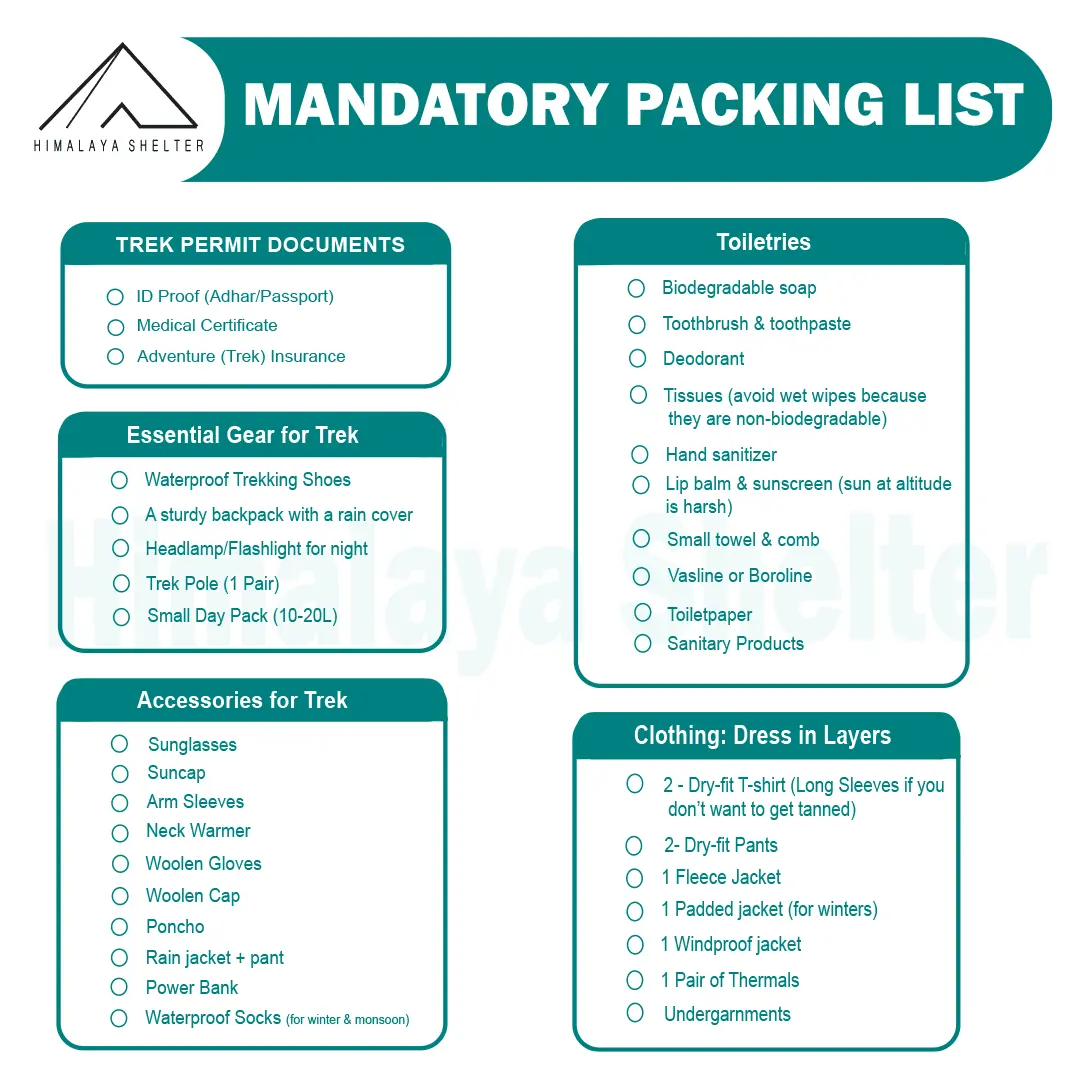
Mandatory Backpacking List for Kashmir Great Lakes
To overcome the difficulty level of KGL Trek, it requires strong cardiovascular endurance, muscular strength, and overall fitness. Incorporate these exercises into your routine to increase strength, stability, and stamina, which will help you tackle the difficult terrain of the trail at high altitudes.
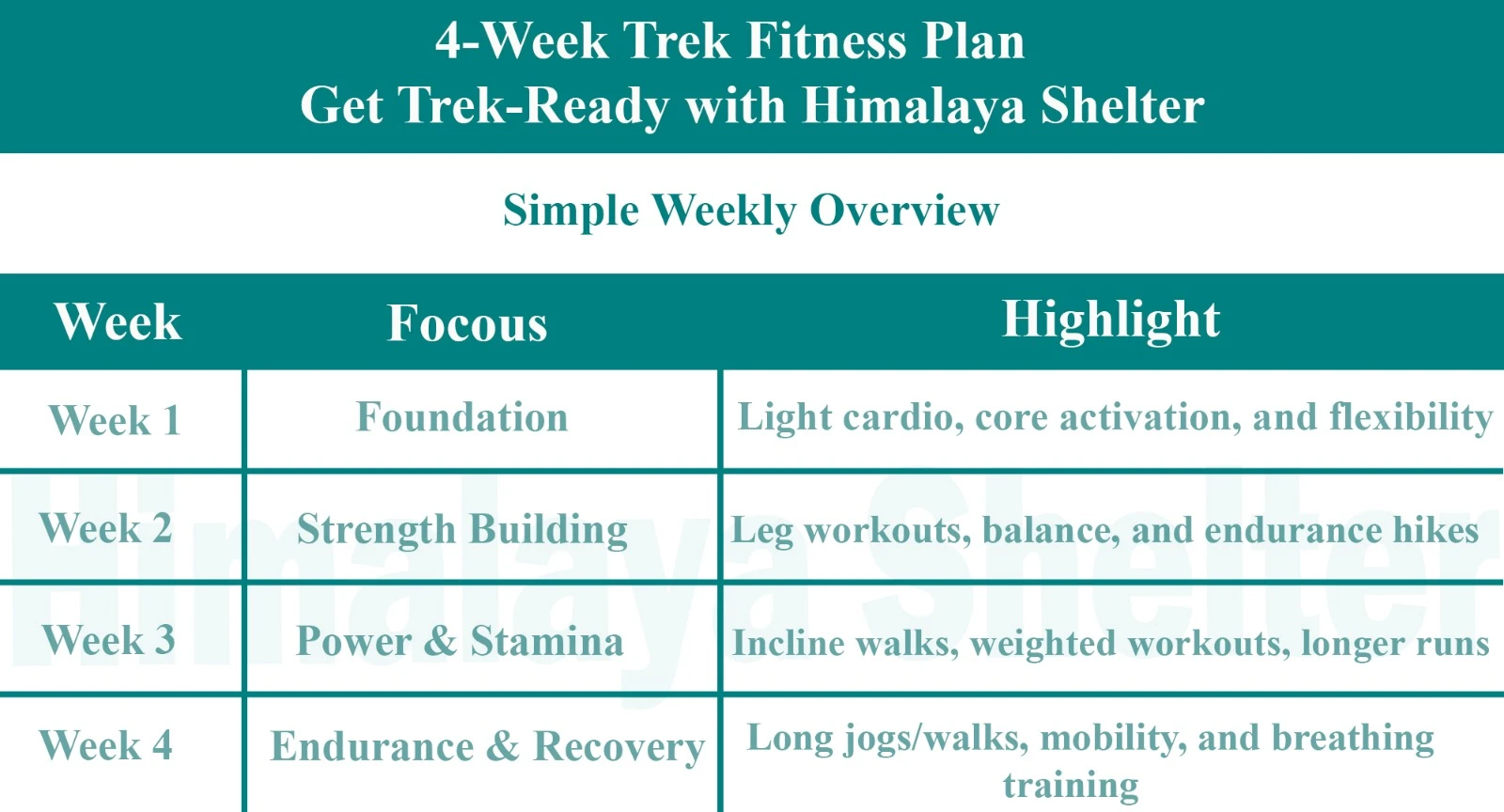
Overview
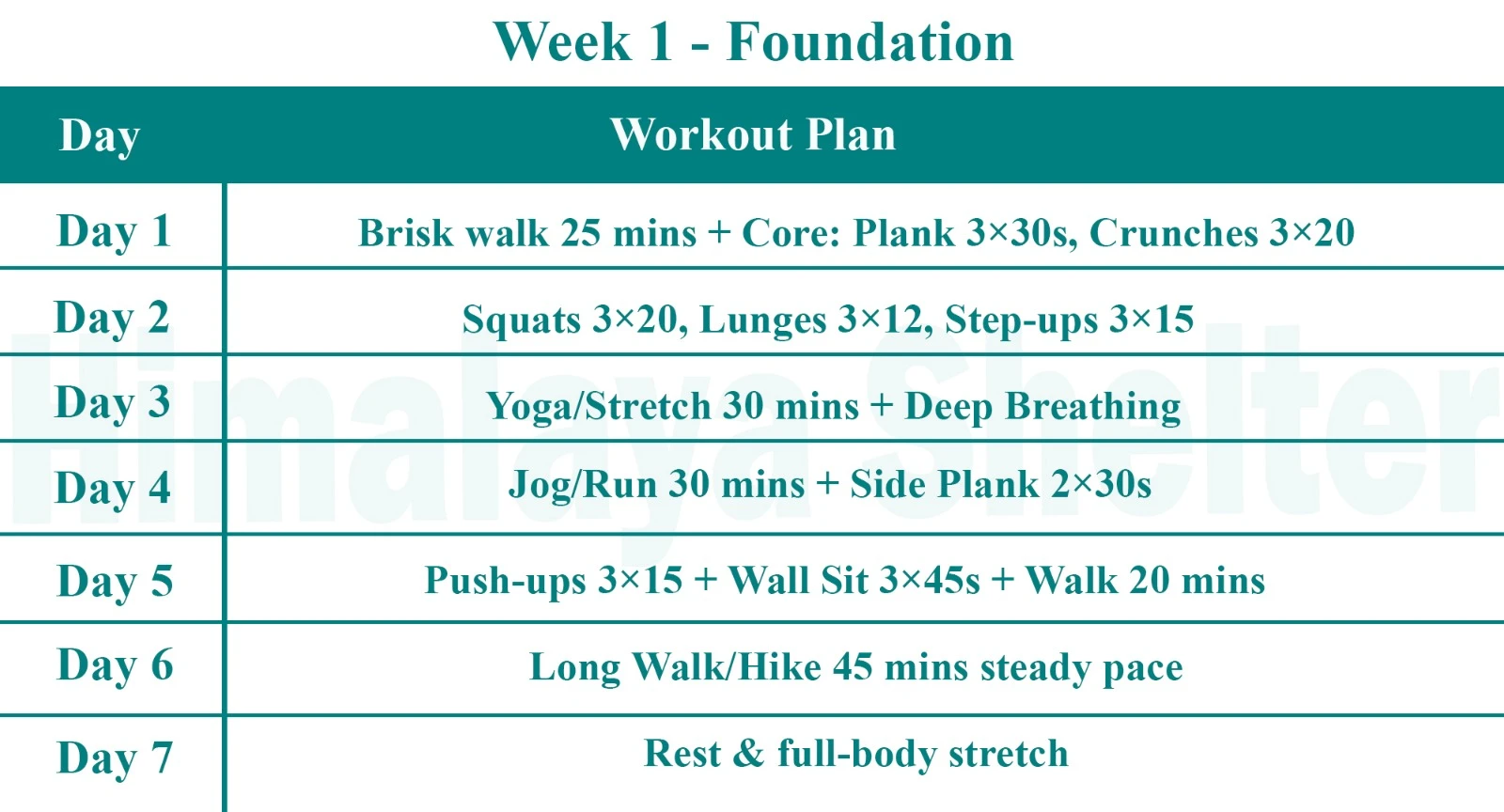
Foundation
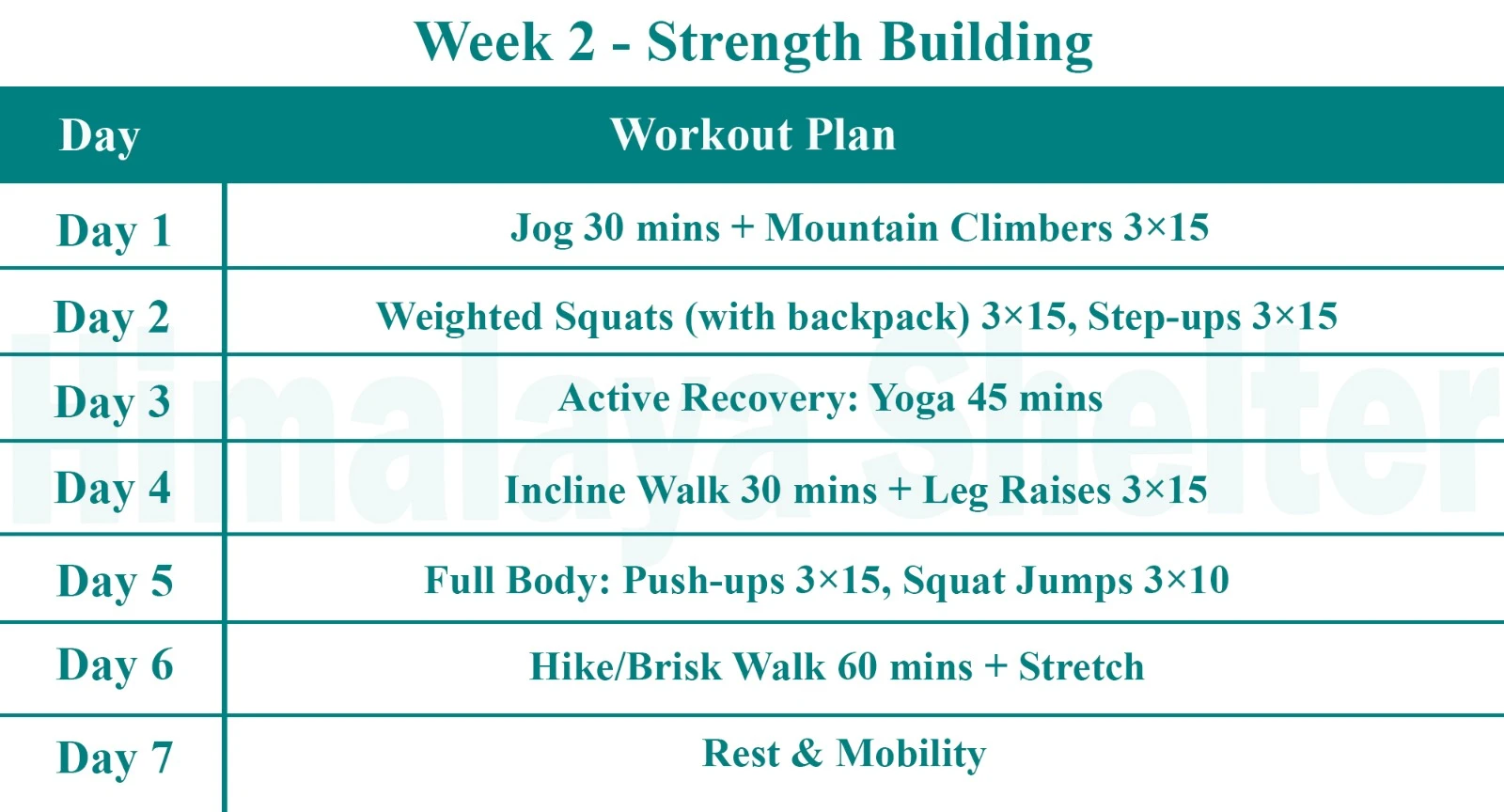
Strength & Building
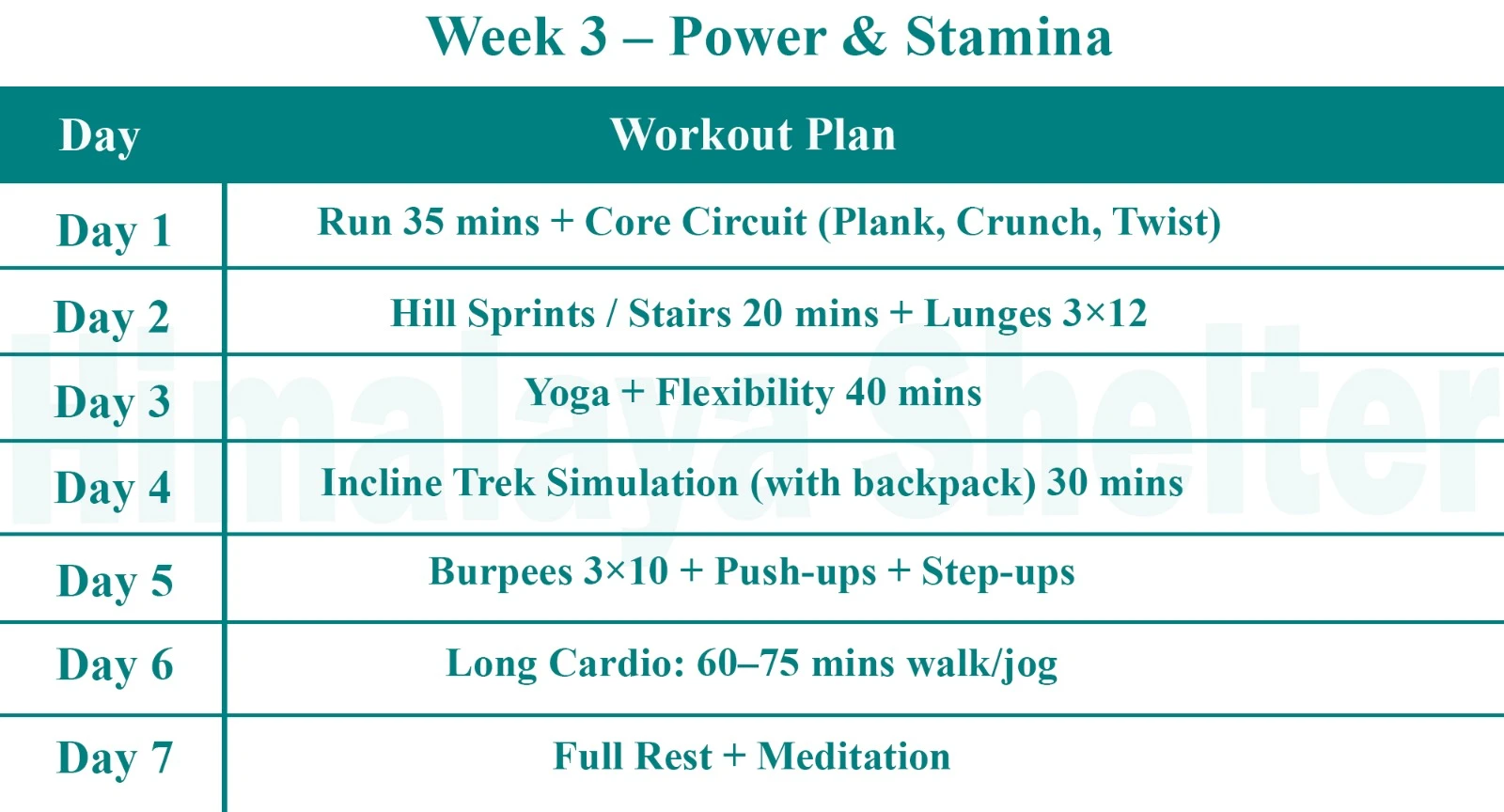
Power & Stamina
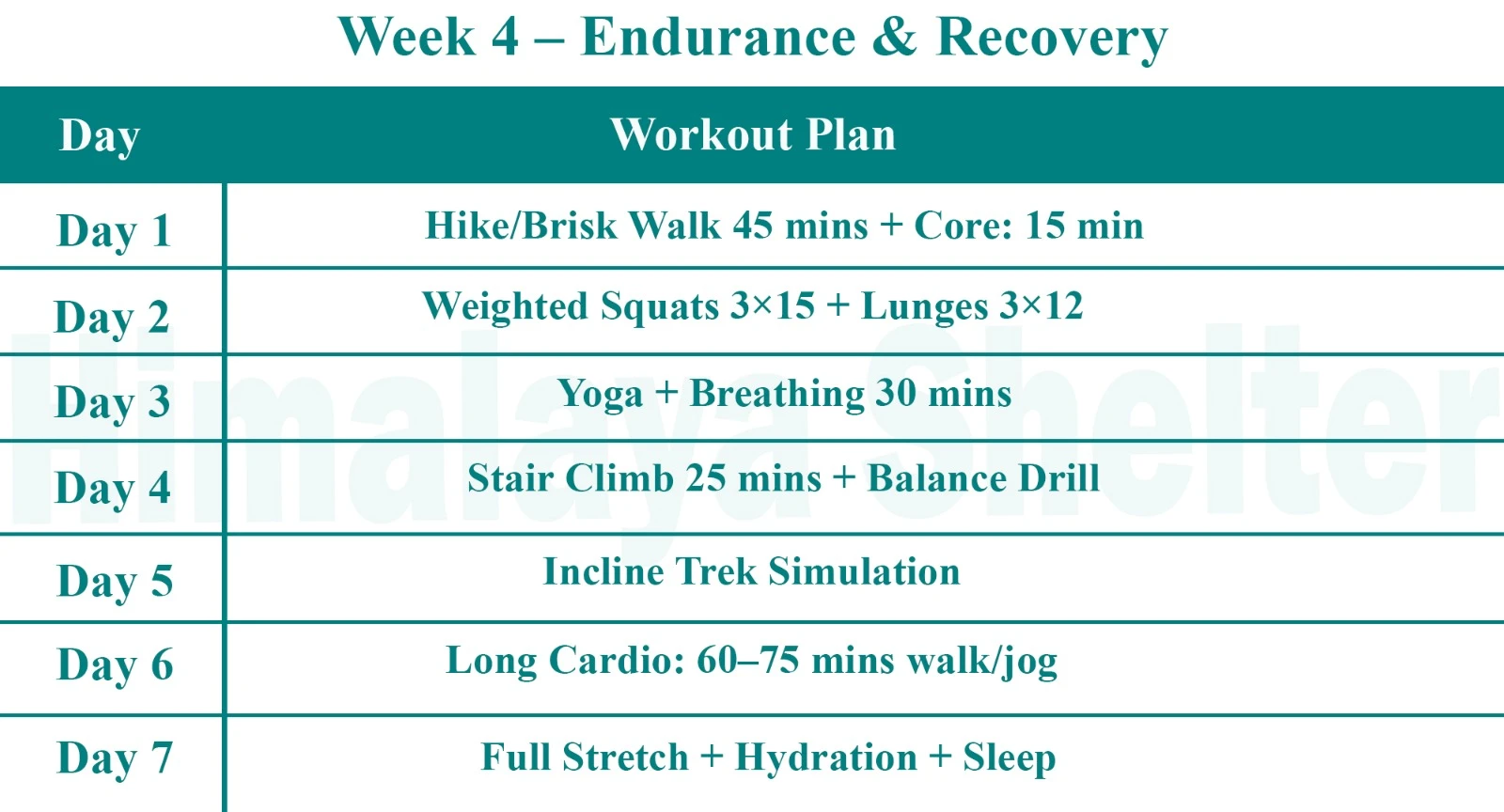
Endurance & Recovery
Day 1: Drive from Srinagar to Gagangir
Drive: 81 km, 2-3 hrs
Trek: 0.5 km to reach the campsite
Altitude: 5,220 ft (1,590 m) – 9,022 ft (2,750 m)
Accommodation: Camping (Alpine Tents)
Meals: Dinner
We leave Srinagar around 1 PM and reach Sonamarg by 4:30 PM, following the Sind River. Once we cross over to the true right of the river at Wayil Bridge, which is 25 KM ahead of Srinagar, we encounter the Anchar lake of Srinagar on the way. The drive is a gradual climb all the way to Sonamarg, and from an altitude of 1,600 meters at Srinagar, we reach a modest altitude of slightly over 2,700 meters at Sonamarg. We will camp overnight at Shitkadi and will have to walk a short distance of 500 meters to reach our campsite.
Your trek leader will inform you in detail about the entire trek, giving you all the details that you need. The campsite is located next to a stream offering a stunning view of Thajiwas Glacier. There is no sound other than the gentle music of the river.

Day 2: Trek from Sonmarg camp to Nichinai Camp
Trek: 11 km, 5-6 hrs
Altitude: 9,022 ft (2,750 m) – 11,811 ft (3,600 m)
Accommodation: Camping (Alpine Tents)
Meals: Breakfast + Lunch + Evening Snacks + Dinner
From our camp at Shitkadi, we start the trek towards the Nichinai camp. Throughout the day, we follow the Nichinai stream, which is on our right.
After a 1.5 KM trek upstream, we arrive at a meadow with maple trees dotting the landscape, along with pines. The trail continues to climb up the ridge, and as we gain more altitude, the view towards Sonamarg becomes quite picturesque.
The maples continue all the way up to the top of the ridge, lining the eastern slope of the ridge. As we reach the top of the ridge, the place is called Table Top, one of the highest points, providing spectacular views of both the Sonmarg Valley and the Amarnath Valley. From here you can engage the local people and shepherds. It is also a lunch point and you can eat Maggie and other local goodies placed by the shops around the Table Top after that an open grassland paves the way that gradually descends to some distance. To the west of the grassland, silver birch (Bhojpatra) trees stand tall, while to the east, the maples can still be seen. This meadow, known as Shekdur, runs almost 1.5 KM long. As we approach its end, the trail then enters the forest of silver birch for almost 1 KM before the treeline finally comes to an end.
Henceforth, we continue on the trail marked by patches of grassland and stone all the way to Nichinai. We are surrounded by tall mountains on either side and towards our back lie the snow-covered mountains far across the Sonamarg valley. We will reach Nichinai by early evening and set up the camps.

Day 3: Trek from Nichinai to Vishnusar (Vishansar) & Kishansar Lakes via Nichinai Pass
Trek: 13 km, 6 hrs
Altitude: 11,811 ft (3,600 m) – 13,100 ft (3,993 m)
Accommodation: Camping (Alpine Tents)
Meals: Breakfast + Lunch + Evening Snacks + Dinner
The trek from Nichinai camp starts with an ascent to the Nichinai Pass. The altitude of Nichinai Pass is around 13,100 Feet, which is quite close to the altitude of Hampta Pass or the Sar Pass, and higher than Kuari Pass. So, take pride in the fact that so early into the trek, you have already crossed over a pass. The ascent takes a good couple of hours to reach the pass from the campsite at a moderate pace.
As soon as we cross over the Nichinai Pass, we can see a small lake at the base of the mountain to our left. There is another larger lake, almost 500 meters in length, around 2 KM ahead, but it cannot be seen unless we climb up to the ridge to our right.
The trail continues downhill from the pass and enters grassland with a gentle slope after an hour of descent. From here, the trail is gentle up to the Vishansar Lake. It’s a few KM before we reach the base of the lake and our campsite. The lake will require another 20 mins to reach as it is slightly higher in altitude. Kishansar is further ahead of the Vishansar lake and higher in altitude still.
The lakes are quite large, and while the Vishansar runs 1.1 KM long and a little over 700 meters wide, the Kishansar is slightly smaller at 900 meters long and 550 meters wide. The latter’s shape is more of a triangular one with an inward arc on one side.
After reaching the campsite which is near the Vishansar Lake or below the Vishansar Lake, you can spend some time over there around the lake, this campsite is considered one of the best campsites of this KGL trek

Day 4: Trek from Vishansar lake (Vishnusar) to Gadsar via Gadsar pass
Trek: 16 km, 7-8 hrs
Altitude: 13,100 ft (3,993 m) – 13, 813 ft (4,210 m) – 12,500 ft (3,810 m)
Accommodation: Camping (Alpine Tents)
Meals: Breakfast + Lunch + Evening Snacks + Dinner
The trek from Vishansar to Gadsar is beautiful but demanding. Today’s trek will take you across the highest point of the entire trek, at a modest altitude of 4,210 meters at the Gadsar Pass.
The trail from the Vishansar campsite continues to the right, with Kishansar lake on our left as we cross it. The trail then starts climbing with a steep ascent all the way to the pass, and the trail that cuts across the mountain in zig-zags can be seen from far away.
It will take around 2 hours to reach the Gadsar Pass. As we climb higher, we are rewarded with magnificent views of the two lakes as we turn our backs. Take some time to capture these moments in your mind, as you will cherish them for the rest of your life.
As you come down from the Gadsar Pass, you will be amazed to see the beauty of Gadasr Lake. It is considered to be one of the most beautiful lakes of this trek and you can enjoy your packed lunch here while admiring the scenery.

From the Pass we can see a few smaller lakes and far off in the distance is the Gadsar lake.
Day 5: Trek from Gadsar to Satsar
Trek: 12 km, 6 hrs
Altitude: 12,500 ft (3,810 m) – 12,007 ft (3,660 m)
Accommodation: Camping (Alpine Tents)
Meals: Breakfast + Lunch + Evening Snacks + Dinner
The trek from Gadsar to Satsar starts with an initial steep hike that will take a little over an hour, After that, gradually trek on the ridge. While passing that ridge, you will witness the majestic Nanga Parbat (8,126). The trail then opens to plain meadows and a water stream. You can have your packed lunch here. Afterward, gradually ascend to rocky terrain, and after some time, you will reach the Satsar campsite
This will be a relatively easier day compared to other trek days. The KGL Trek is indeed a trek with long walking distance but today, this trek will offer you a good time to rest/explore.

Day 6: Trek from Satsar to Gangabal Lake and Nund Kol Lake via Zaj Pass
Trek: 9 km, 5-6 hr
Altitude: 12,007 ft (3,660 m) – 11,482 ft (3,500 m)
Accommodation: Camping (Alpine Tents)
Meals: Breakfast + Lunch + Evening Snacks + Dinner
The trek starts with an ascent to the Zaj Pass, the trail to the Zaj Pass you have to cross the boulder’s path
The altitude of the Zaj Pass is lower than the former two passes we crossed before along the trail with an altitude of 13,228 feet, it takes 2 hours to reach the pass from the pass you can see Gangbal and Nandkul lakes
The view from the pass is very beautiful The trail descends steeply and then gradually descends, making it enjoyable to walk upon.

Day 7: Trek from Gangabal lake to Naranag & drive to Srinagar
Trek: 13 km, 5-6 hrs
Drive: 50 km, 2 hrs
Altitude: 11,482 ft (3,500 m) – 7,447 ft (2,270 m)
Meals: Breakfast
On the last trekking day, after half an hour of trekking, we reached the Army check post where it took half an hour to check the documents (Adhar Card) of all the trekkers.
Then, we move ahead while the trail oscillates between minor ascents and descents up to halfway, after which there is a steep descent amid pine forests all the way to Naranag. Our beautiful KGL Trek ends here.
We arrive in Srinagar between 5 and 7 PM, depending on the start time from Gangabal. We are sure that you will get so many pleasant memories to cherish by embarking on the Trek with Himalaya Shelter.

Day 8: Buffer Day
Buffer Day: You have to pay us Rs. 2929 INR per day (Plus 5% GST) if you use the buffer day. The money will be collected by the Trek Leader only if we use the buffer day.
Trek Package Inclusions
Our treks are specially designed by the experienced team at Himalaya Shelter, taking you on an adventure of a lifetime all while making you connect not only with the bountiful nature but also with yourself and with others on the trek with you, creating wonderful memories which will last you a lifetime. All Himalaya Shelter treks are guided by experienced Trekkers having vast knowledge and experience of the region, providing with insightful information and stories pertaining to the region’s flora and fauna and the history of the region, whilst on the trek. It is safe to say that on successfully completing the trek, one will gain tremendous insight and experience along with lifetime memories.
- Transport support from Srinagr to Srinagar ( Pick-up location: Nishat Garden, Srinagar )
- Accommodation – At Base Camp, stay at a local homestay or guest house for one night each, which will give you an insight into the authentic lifestyle of the locals.( INR 5000 per person extra for single sharing throughout the trek )
On Trek stay in a 2-person Vango Halo Pro/A-Shape tent, which is to be shared by two trekkers, built to withstand extreme weather conditions and at the same time making you comfortable after a hard day’s trek. - Camping Equipment – specially designed sleeping bags that can withstand harsh weather conditions, foam mattresses. Other safety gear like microspikes, gaiters, an ice axe, and helmets will be provided.
- Medical Kit – our team will be equipped with an extensive medical kit, which our team is trained and experienced to use. Oxygen cylinders are used after they are thoroughly inspected throughout the Trek. Even campsites have large oxygen cylinders as backups.
- Permission - Forest entry charges for Indian nationals (Additional charges will be applicable for international tourists)
- Meals – Breakfast, packed lunch (on trek days), evening snacks, and dinner will be served. A hearty, delicious, and nutrition-filled Veg meals with egg preparation will be provided throughout the trek. (Jain and Vegan Food can also be arranged on prior notification.)There will be a dedicated Kitchen Tent along with a dining tent, which will have a dining table too.
- Our Team – A highly experienced and AMC-certified Trek Leader who will help ensure that the entire trek goes smoothly and safely while navigating the challenging conditions during the trek, and is skilled enough to navigate any medical emergency that can arise during the trek. Local and route Guides who are well-versed with the region and provide an in-depth insight into the local customs and knowledge of the flora and fauna endemic to the region. A dedicated Kitchen staff, which includes a Cook, a helper, and other support staff. There will also be porters and mules to carry common equipment.
- Cloakroom - We have a cloakroom facility available for extra luggage. Every trekker is permitted to leave their luggage behind at no charge.
Exclusions
- Personal expenses like tips, personal medicines, phone calls etc.
- Travel Expenses - Travel expenses from your hometown to the mentioned Pick-Up Point are not included in the trek fee.
From the scheduled pick-up spot to the base camp, we have our own fleet of vehicles like Bolero, Innova, Dezire, or Tempo Traveler (12-seater). This is be shared by trekkers for a pre-decided amount. All vehicles are non-AC. - Personal Equipment - Any personal gear like jackets, shoes, cutlery, or backpacks are not included in the trek fee. We recommend renting them from our Rental Store for an affordable fee. This can be pre-arranged to avoid last-minute hang-ups.
- Offloading - We encourage carrying your backpack to get into the true spirit of trekking. However, if needed, you can opt to offload your personal luggage of up to 12 kgs for an additional cost of INR 600 per bag per day.
- Trek Insurance - A mandatory trek insurance fee is charged in addition to your trek fee. Since most medical insurance doesn’t cover adventure activities, trek insurance offers essential coverage, enhancing your safety without a significant financial burden.
- Buffer day on the trek - We have kept a buffer day on the trek to account for any weather-related delay. If this is utilized, you will need to pay an extra amount to your trek leader.
- Anything apart from inclusions
- Please carry a lunch box for a packed lunch/breakfast to avoid using polythene and Aluminium foil.
Keeping the Himalayas clean is our own responsibility. Reduce the use of Plastic when you are in the abode of the Sacred Himalaya. 🌱
.
In total, there are 6 beautiful lakes that you will witness during the Kashmir Great Lakes Trek. All these 6 lakes are Alpine Lakes located in the High Altitude Himalayan mountains. The name of the Lakes of KGL trek are as follows: Vishansar Lake (Vishnusar Lake) Krishansar Lake Gadsar Lake Satsar Lakes Gangabal Lake Nundkol Lake
KGL Trek is once in a lifetime. It is one of the most beautiful walks in India, with its fantastic alpine grasslands, Crystal-clear Lakes and fantastic Himalayan views. If you love trekking, it should definitely be on the bucket list!
Kashmir Great Lakes Trek Videos
About the Great Lakes Trek
Read More on Kashmir Great Lakes Trek
Photo Gallery












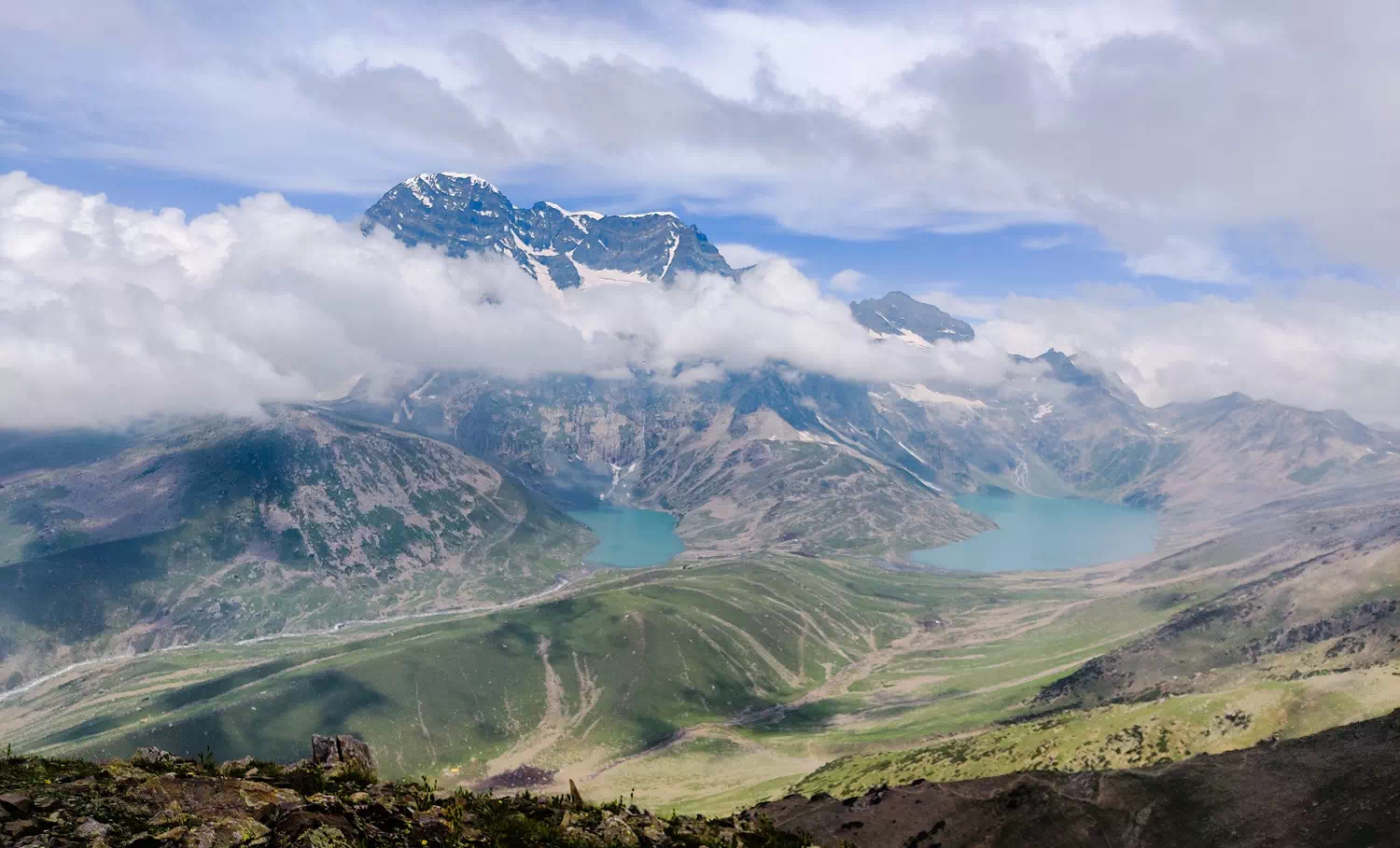
Treks by Categories
Treks By Month

Treks By Experience


